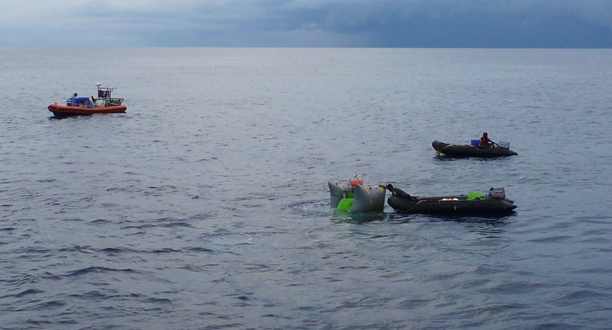A Critical Step

Jacquinot Bay, New Britain Island, Papua New Guinea
Today, Jim spent six hours at 12,000 feet (3,658 meters). Guided by his intuition and headings called down from the communications team on the ship, he travelled three miles (five kilometers) over the seafloor and made separate rendezvous with the two landers, Mike and Andrew. “It was a great ride,” he told us after the dive. “Especially during ascent, when I came up like a spaceship.”
Two hours before this scheduled test dive, Jim had been on the main deck, in the sizzling sun, working with the lander crew. He picked up a power drill and helped Erika Montague tighten three hose clamps on the bait cylinder. He talked to Robby Seed and helped him find the perfect position for the camera lights. He knows that the best way to enhance the performance of your team is to work shoulder-to-shoulder with them in the heat.
During the past five weeks, he’s repeated this process with the camera crew, the sub team, and the ship’s crew. I’ve seen him with 3-D cameras on his shoulder, batteries in his arms, and tag lines in his hands. One unspoken message is that diving a new sub into the cold heart of the ocean is a collective uphill fight and requires commitment, confidence, and stamina. Another is that a great team never falters just because things are unbelievably hard. Watching Jim at work directing the expedition, piloting a sub, and shooting film is like watching a magician doing many things rapidly, expertly, and all at once.
At 4 p.m., with a towering, anvil-shaped cloud blocking out the sun, the DEEPSEA CHALLENGER was lowered into a calm ocean. Less than an hour later, Jim was at 6,000 feet (1,829 meters), spiraling slowly downward at two knots.
As we sat on the bridge of the Mermaid Sapphire tracking the rate of his descent, some of us tried to imagine what is was like inside a small sphere falling two miles (three kilometers) through liquid darkness. Rows of glowing, blinking instruments inhibit every movement. The oxygen going into your lungs hisses out of a high-pressure cylinder. The sauna-like temperature is starting to drop, but you’re still wiping the sweat out of your eyes.
I tried to imagine his thoughts. Jim was diving 9,000 feet (2,743 meters) deeper than his last dive, and hard questions might be coming to mind. What if the penetrator plate leaks? What if there’s a life-support malfunction? What if there’s a fire? But the man inside the DEEPSEA CHALLENGER has made 72 deep submersible dives, including 33 to Titanic. He’s lived through moments similar to this and been focused on the operational tasks. His mind was wrapped around a Medusa of things to think about, but they were all positive. They had to be.
Seventy minutes after leaving the surface, Jim was on the bottom running through his seafloor checklist. Soon after, with the sub’s array of LED lights parting the darkness and the 3-D cameras running, he eased forward on the horizontal thrusters and began flying over an ocean floor that sloped gently downward. He saw dark-shadowed ledges, a fast-moving eel, and a creature-created starburst of lines in the sediment. He encountered a small white octopus with outspread tentacles. At one point he stopped the sub, pushed a small core into the sediments and tried to recover a sample, but the dust-like particles kept streaming out of the core. He made a mental note: “Brush up on my core sampling technique.”
The seven-hour dive was a critical step in our journey to the Challenger Deep. It was reinforcement that, in spite of delays and setbacks, we have a cool diving machine that works. It confirmed that humans are at their best on a frontier. Getting the DEEPSEA CHALLENGER down to the seafloor and safely back on the deck of the ship forced us to find the best of our intentions, the best of our innovations, and the best of our collaborations.
Photograph by Joe MacInnis



